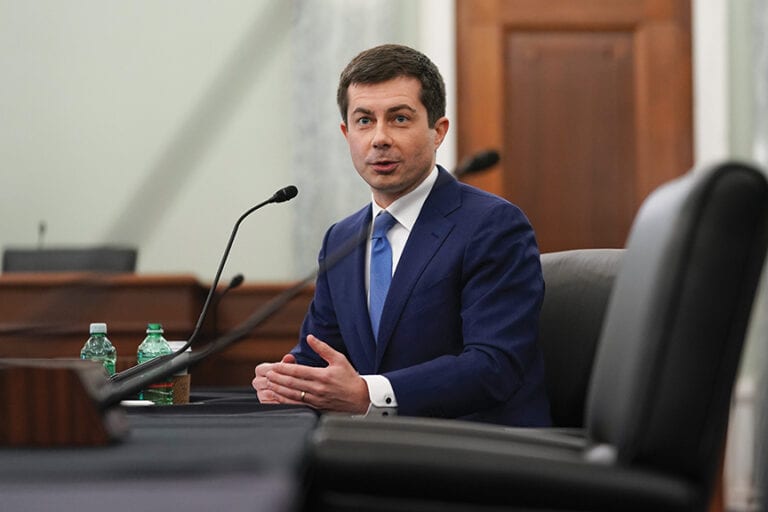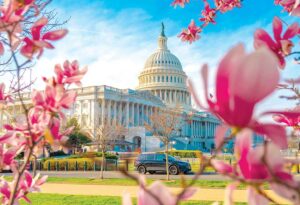President Joe Biden wasted no time in making major Cabinet appointments, announcing Pete Buttigieg as his choice for the U.S. Department of Transportation secretary on December 16, 2020.
With a 21-3 vote, Buttigieg breezed through a confirmation hearing with the Senate Commerce, Science, and Transportation Committee on January 21, winning praise from committee members for his testimony.
On February 2, the full Senate voted 86-13 to confirm Buttigieg to head the department.
The new administration’s handling of some key issues will undoubtedly impact the trucking industry. Infrastructure looms large, both in the plan to address roads and bridges that are in poor condition and in the methods used to fund the Highway Trust Fund (HTF). Other issues include fuel pricing, hours-of-service pilot programs that could improve driver productivity, an increase to the minimum financial requirements for carriers, and more.
So, exactly who is Pete Buttigieg?
Peter Paul Montgomery Buttigieg was born January 19, 1982, in South Bend, Indiana, best known as the home of Notre Dame University.
He earned degrees from Harvard University and Pembroke College in Oxford, England.
He served in the U.S. Navy and fought in the war in Afghanistan, eventually receiving the Joint Service Commendation Medal, a mid-level U.S. military decoration presented for sustained acts of heroism or meritorious service.
He first became a national figure when he decided to run for the Democratic presidential nomination on April 19, 2019, near the end of an eight-year term as mayor of his hometown.
Published reports say Buttigieg gained significant momentum in mid-2019 when he participated in several town halls and debates. Buttigieg narrowly won the Iowa caucuses and placed a close second in the New Hampshire primary. Despite the early successes, he dropped out of the race on March 1, 2020, and endorsed then-presidential candidate Joe Biden the following day.
Buttigieg’s tenure as mayor won him both supporters and opponents.
CNN reported that those who are familiar with Buttigieg’s work in South Bend say he’s well suited for the federal job given his track record, intellect, and view that transportation is about more than moving vehicles. They point to his success in revitalizing South Bend’s downtown. He redesigned streets, which attracted new businesses, boosted property values, and made the city safer for pedestrians.
They also point to the unemployment rate that dropped from 15.5% when he took office to 9% in 2017, and then to 5.9% in late 2020.
Critics say he was focused on statistics and spreadsheets rather than implementation of programs supported by those same statistics.
They point to 2015, when Buttigieg announced an initiative to work on the city’s problem of vacant and abandoned housing after a 2013 Notre Dame report identified 1,900 vacant and 1,275 abandoned properties in South Bend.
Buttigieg proposed to rehab or demolish 1,000 vacant and abandoned homes in 1,000 days, and by all rights, the program accomplished that goal with time to spare. As a presidential contender, Buttigieg announced plans to tackle the issue nationwide.
Yet despite accomplishing the 1,000 homes in 1,000 days target, the problem continued to get worse in South Bend. In 2009, well before Buttigieg took office, South Bend had 48,683 total housing units, 41,367 of which were occupied and 7,316 that were vacant, giving the city a vacancy rate of 15%.
As of 2017, there were 8,255 vacant units out of 47,280 total, for a vacancy rate of 17.5% according to the American Community Survey data.
After Buttigieg’s confirmation hearing, one senator dismissed the former mayor’s background and approach.
Sen. Roger Marshall (R-Kan.) said Buttigieg lacked the experience to lead the Department of Transportation.
“Fixing municipal potholes and managing bus routes in no way equates to what he will oversee at DOT,” Marshall said in a statement. “It is troubling that Pete Buttigieg has openly talked about using his post as a pulpit for social agenda items and supports the cancellation of the Keystone XL pipeline.”
But Transportation for America Director Beth Osbourne said it would be difficult to find a single leader with the professional background to oversee aviation, trucking, cars, pipelines, highway funding, and shipping. Instead, Osborne said Buttigieg’s success depends on his ability to work with a team of deputies and agency leaders.
Buttigieg has unveiled a plan to pour more than $1 trillion into creating millions of jobs and updating U.S. infrastructure with an eye toward fending off the effects of climate change.
The 17-page plan calls for working with states, cities, and local governments to build sustainable infrastructure that also builds “opportunity, equity, and empowerment.”
“When our infrastructure works well, we hardly notice,” the Buttigieg plan states. “These days, we notice our infrastructure a lot.”
Buttigieg said his plan would create 6 million jobs with “strong labor protections”; ensure access to clean drinking water while lowering water bills across the U.S. and protecting against lead in paint and water; repair roads and bridges in poor condition by 2030; and invest in sustainable infrastructure that enables 50% of the country to grow over the next 10 years.
Buttigieg’s plan says it would prioritize connecting people with jobs and resources. He would double the Transportation Department’s BUILD grant program, which funds a wide variety of infrastructure projects, to $2 billion a year.
The plan also includes provisions for road safety, something that wasn’t detailed in the infrastructure proposals put forward by other leading Democratic presidential candidates. He calls for a national “Vision Zero” policy to work toward eliminating traffic fatalities and serious injuries, as well as doubling funding for the Transportation Alternatives Program to install more accessible sidewalks, crosswalks, and bike lanes.
So, those who have been clamoring for a comprehensive infrastructure plan may soon see it happen. Democratic control of both chambers of Congress as well as the White House virtually assures passage of the next transportation plan that is included with an overarching infrastructure plan. The next transportation plan will likely be very similar to the $1.5 trillion Moving America Forward (MAF) bill the Democrats pushed through the House of Representatives in June.
The bill languished in the then-Republican-controlled Senate, making good the promise of then-Majority Leader Mitch McConnell that it would “go nowhere” in the upper chamber.
During his confirmation hearing, when asked about hours-of-service pilot programs paused by Biden’s January 20 regulatory freeze executive order, Buttigieg said, “We’ll look into it,” providing similar answers to other questions.
The executive order covered hundreds of programs across the federal government that were paused to allow new political appointees time to review and determine the fate of each one. This a common practice when a new administration takes office.
When the topic of highway funding came up, Buttigieg initially spoke in favor of increasing federal fuel taxes in the short term, but later in the day, a Buttigieg spokesperson walked back support for a fuel tax increase, telling reporters that a “variety of options need to be on the table to ensure we can invest in our highways and create jobs, but increasing the gas tax is not among them.”
Unlike his predecessor, Buttigieg has the backing of both houses of Congress. It shouldn’t take long to see how his leadership will impact the trucking industry.
Cliff Abbott is an experienced commercial vehicle driver and owner-operator who still holds a CDL in his home state of Alabama. In nearly 40 years in trucking, he’s been an instructor and trainer and has managed safety and recruiting operations for several carriers. Having never lost his love of the road, Cliff has written a book and hundreds of songs and has been writing for The Trucker for more than a decade.








